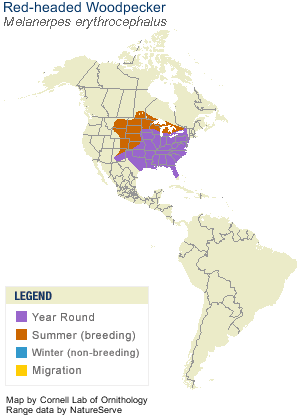We were thrilled to have an adult Red-Headed Woodpecker visit our yard in mid-May of 2010. If you've ever seen one of these woodpeckers, they have eye catching tri-colored plumage of red, white and black. It's the only woodpecker in North America to have a solid red head (when mature).
Red-Headed Woodpecker range includes Montana east to New York, south to Texas and Florida (see map at bottom).
We excitedly told friends about our sighting, most thought we were talking about the more common Red-Bellied Woodpecker which have red on their heads. They are named for the red patch on their lower front.
(Left Photo: Female Red-Bellied Woodpecker)
Red-Headed Woodpecker populations are on a serious decline. "[P]opulations have declined 89% since 1967. The bird has experienced an average decline of 4.6% per year since 1980 due to loss of habitat and other factors." (Red-Headed Woodpecker Recovery Website)
Red-Headed Woodpeckers like open woodland habitats with mature live trees (primarily nut producing trees) and plenty of snags (dead standing trees) for cavity nesting. They also prefer an open understory. Locally, our oak woodland-brushland and oak savannas are ideal habitats except there is usually not enough snags available for nesting cavities.
"Red-heads are primary cavity excavators. They create tree holes for nesting, food storage and roosting. Once abandoned, these cavities become sites for secondary cavity nesters, birds that will not create their own holes but depend on holes left by others. These species include bluebirds, swallows, wrens, flycatchers, kestrels, screech-owls as well as others." (Red-Headed Woodpecker Recovery Website)
"They [b]egin nest-building as early as February and egg-laying as early as mid-April. An average of 4-7 eggs are laid in the cavity and incubated by both parents for 12-14 days. May have two broods per season and will lay a second clutch if first fails. A pair may use the same cavity for several years in a row." (Audubon Website)
Juvenile Red-Headed Woodpeckers have brown heads and black stripes in their white wing patch.
 |
| Image Source: Cornell Lab of Ornithology |
An sightings can be reported at the Red-Headed Recovery website.
More Information
Red-Headed Woodpecker Recovery
Audubon
Cornell Lab of Ornithology





